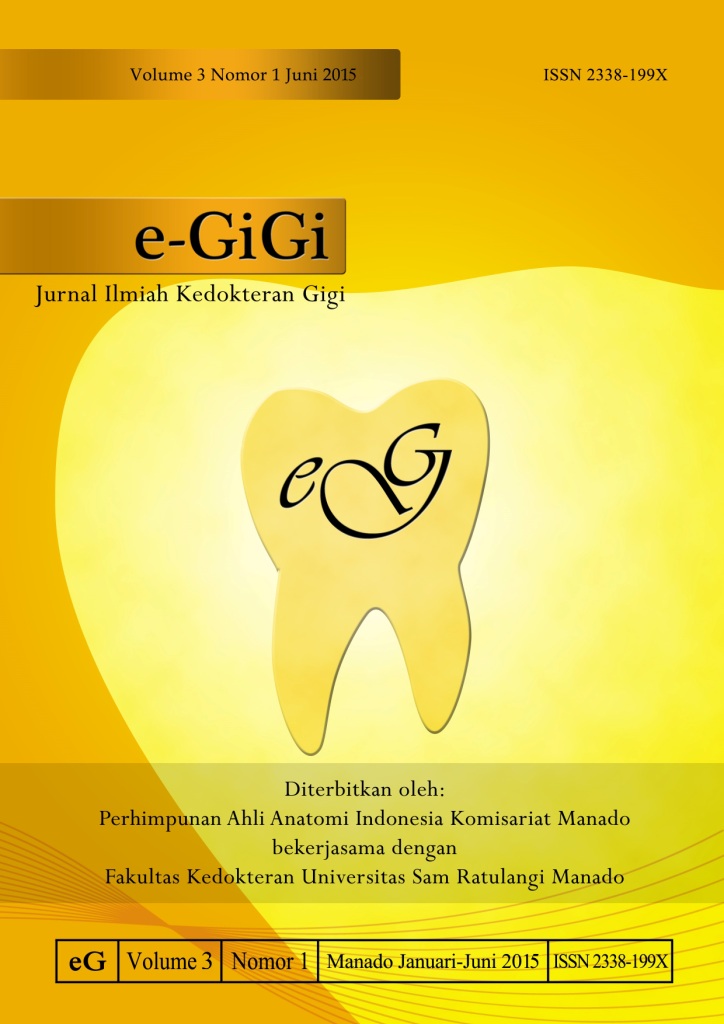GAMBARAN PERILAKU DAN CARA MERAWAT GIGI TIRUAN SEBAGIAN LEPASAN PADA LANSIA DI PANTI WREDHA MINAHASA INDUK
DOI:
https://doi.org/10.35790/eg.3.1.2015.6404Abstract
Abstract: Removable partial dentures (RPDs) is a denture that replaces one or more missing teeth in the maxilla or mandible and can be removed by the patient. Patients maintain hygiene habits removable partial dentures can be seen from the frequency, time, and method used to clean dentures varies between individuals and different communities. The purpose of this study is to describe the behavior and how to care RPDs for the elderly in Panti Wredha Minahasa.This type of research is a descriptive study with cross sectional study. The samples were all elderly who meet the inclusion criteria were age 60-80 years using RPDs in seven nursing homes in Minahasa.Based on the research that has been conducted, most respondents RPDs cleaning by brushing without toothpaste 1 (3.3%) and brushing with toothpaste totaled 29 respondents (96.67%). A total of 13 respondents (43.3%) did immersion RPDs. Most respondents simply did immersion by using water that are 17 respondents (56.67%), and no one do immersion using a chemical solution. Most respondents, 13 respondents (43.3%) RPDs cleaning once a day, as many as 28 respondents (93.33%) did not find any difficulty in cleaning RPDs, all respondents (100%) did not get instruction after assembling, as many as 22 respondents (73.3%) using RPDs at night when sleeping.Conclusion: from the study based on behavior, most respondents use RPDs at night when sleeping. Based on how to brush, most respondents RPDs cleaning by brushing use a toothbrush and toothpaste. Based on how to care for the soaking, most respondents did soaking with water.
Keywords: removable partial dentures, elderly
Abstrak: Gigi tiruan sebagian lepasan (GTSL) adalah gigi tiruan yang menggantikan satu atau beberapa gigi yang hilang pada rahang atas atau rahang bawah dan dapat dilepas oleh pasien. Kebiasaan pasien memelihara kebersihan gigi tiruan sebagian lepasan dapat dilihat dari frekuensi, waktu, dan cara yang digunakan untuk membersihkan gigi tiruan bervariasi pada setiap individu dan masyarakat yang berbeda. Tujuan dari penelitian ini yaitu untuk mengetahui gambaran perilaku dan cara merawat GTSL pada lansia di Panti Wredha Minahasa Induk. Jenis penelitian ini yaitu penelitian deskriptif dengan pendekatan cross sectional study. Sampel adalah semua lansia yang memenuhi kriteria inklusi yaitu yang berusia 60-80 tahun, menggunakan GTSL di tujuh Panti Wredha di Minahasa Induk. Berdasarkan hasil penelitian yang telah dilakukan, responden paling banyak membersihkan GTSL dengan cara menyikat tanpa pasta gigi 1 orang (3,3%) dan menyikat gigi dengan pasta gigi berjumlah 29 responden (96,67%). Sebanyak 13 responden (43,3%) tidak melakukan perendaman GTSL. Responden terbanyak hanya melakukan perendaman dengan menggunakan air yaitu 17 responden (56,67%), dan tidak seorangpun yang melakukan perendaman dengan menggunakan larutan zat kimia. Sebagian besar responden yaitu 13 responden (43,3%) membersihkan GTSL sekali sehari, sebanyak 28 responden (93,33%) tidak menemukan kesulitan dalam membersihkan GTSL, semua responden (100%) tidak mendapatkan isntruksi setelah pemasangan, sebanyak 22 responden (73,3%) menggunakan GTSL pada saat malam hari ketika tidur. Simpulan: dari hasil penelitian berdasarkan perilaku, sebagian besar responden menggunakan GTSL pada saat malam hari ketika tidur. Berdasarkan cara menyikat, responden paling banyak membersihkan GTSL dengan cara menyikat memakai sikat gigi dan pasta gigi. Berdasarkan cara merawat dengan merendam, sebagian besar responden melakukan perendaman dengan menggunakan air.
Kata kunci : gigi tiruan sebagian lepasan, lansia
Downloads
How to Cite
Issue
Section
License
COPYRIGHT
Authors who publish with this journal agree to the following terms:
Authors hold their copyright and grant this journal the privilege of first publication, with the work simultaneously licensed under a Creative Commons Attribution License that permits others to impart the work with an acknowledgment of the work's origin and initial publication by this journal.
Authors can enter into separate or additional contractual arrangements for the non-exclusive distribution of the journal's published version of the work (for example, post it to an institutional repository or publish it in a book), with an acknowledgment of its underlying publication in this journal.
Authors are permitted and encouraged to post their work online (for example, in institutional repositories or on their website) as it can lead to productive exchanges, as well as earlier and greater citation of the published work (See The Effect of Open Access).






